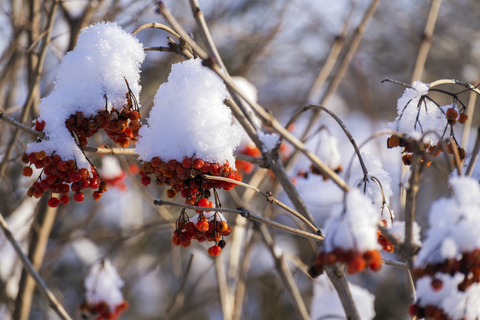Cramp Bark

Also known as Viburnum opulus, Guelder rose, Black Haw, Cranberry Tree, Dog Rowan Tree, Viburnum, May Elder, King's Crown, and May Rose.
Introduction Cramp bark is a large deciduous shrub growing as much as 15 feet (5 m) tall and 15 feet wide. It is native to the moist lowland forests of England and Scotland and naturalized to moist forests of the northern United States and southern Canada. The bark is stripped before the leaves change color in the fall, or before the buds open in the spring. A member of the honeysuckle family, cramp bark bears large white flowers, up to 5 inches (12 cm) across that yield red berries in the fall. The berries are eaten like cranberries, although moderation is recommended. Historically, the berries, once dried, have been used for making ink.
Constituents Coumarins, scopoletin, tannin.
Parts Used Dried bark, harvested in the autumn before leaves change color or in the spring before leaves open. The leaves and fruit are used in laxatives.
Typical Preparations Teas or tinctures. In rare instances, used as a ground herb administered in capsules. Often combined with corydalis and/or valerian for pain.
Summary Cramp bark, as its name suggests, is used to treat cramps and spasms of all types. The bark is antispasmodic, astringent, and sedative, especially in the uterus. As a muscle relaxant it also relaxes the intestines, and skeletal muscles. Cramp bark has been traditionally used by Native American and pioneer women to relieve menstrual cramps and spasms after childbirth and to prevent miscarriage. The herb is also popularly used in combinations to treat asthma and nervous cough.
Precautions Cramp bark is essentially nontoxic, although taking large quantities of the fruit or leaf can cause diarrhea. Some reports have shown that people with sensitivity to aspirin may also have a sensitivity to cramp bark, so caution should be exercised.
For educational purposes only. This information has not been evaluated by the Food and Drug Administration. This information is not intended to diagnose, treat, cure, or prevent any disease.
This information courtesy of MOUNTAIN ROSE HERBS, with full, written permission for reuse. For further traditional information concerning Cramp Bark, please visit this excellent resource from Botanical.com. Used with full, written permission.







